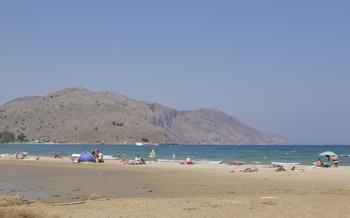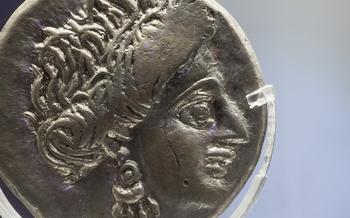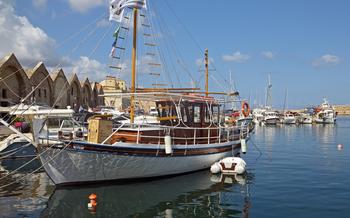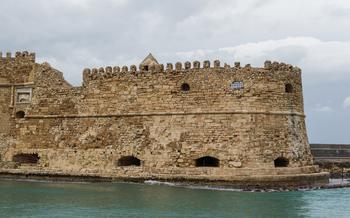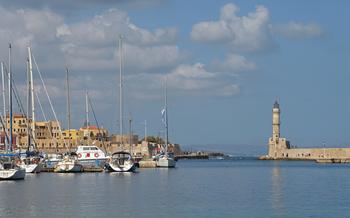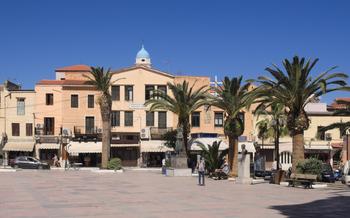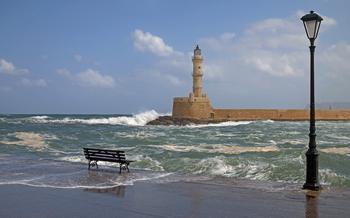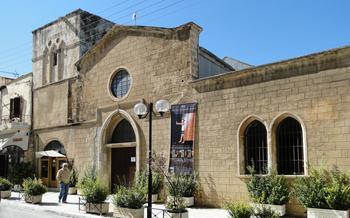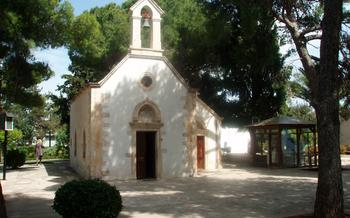
The Venetian Neoria
- Historical Background
- Architectural Features
- Significance and Recognition
- Current Use and Transformation
- Visitor Experience
- Practical Information
- Nearby Attractions
- The Venetian Arsenal
- The Maritime Museum of Crete
- Local Folklore and Traditions
- Shopping and Dining
- Photography Opportunities
- Historical Reenactments
- Cultural Events and Festivals
- Insider Tip:
Historical Background
The Venetian Neoria, located in the picturesque city of Chania on the island of Crete, holds a significant place in maritime history. Built in the 14th century during the Venetian rule, this shipyard played a crucial role in the Republic of Venice's maritime trade and naval power. The Neoria, meaning "shipyards" in Greek, consisted of a complex of vaulted chambers and arched entrances carved into the rocky hillside. These structures provided shelter and maintenance facilities for Venice's mighty fleet, which traversed the Mediterranean Sea, facilitating trade and safeguarding the Venetian Empire's maritime supremacy. The Neoria served as a vital hub for shipbuilding, repairs, and the storage of naval supplies, solidifying Chania's position as a strategic naval base.
Architectural Features
The Venetian Neoria stands out for its unique architectural features, reflecting the ingenuity and craftsmanship of the Venetian builders. The Neoria comprises a series of vaulted chambers arranged in a row, each with arched entrances facing the sea. These vaulted chambers, known as 'darsena' in Italian, served as individual dry docks for ship construction and repair. The vaulted ceilings, supported by massive stone pillars, provided stability and protection for the ships inside.
The construction of the Neoria showcased advanced engineering techniques. The use of vaulted chambers allowed for the efficient distribution of weight and ensured the structural integrity of the complex. The arched entrances, designed with a pointed Gothic style, not only facilitated the movement of ships in and out of the docks but also added an aesthetic element to the overall design.
The materials used in the construction of the Neoria were carefully selected for their durability and resilience. Local limestone, known for its strength and resistance to erosion, was the primary building material. The use of stone ensured that the Neoria could withstand the harsh marine environment and the test of time.
The architectural style of the Venetian Neoria is a testament to the influence of Venetian architecture on the island of Crete. The pointed Gothic arches, the vaulted ceilings, and the use of stone are all characteristic elements of Venetian architecture, which left a lasting legacy on the island's built environment.
Significance and Recognition
The Venetian Neoria's exceptional historical and architectural value has been widely recognized. In 1985, it was declared a UNESCO World Heritage Site, a testament to its outstanding universal value. Additionally, the Neoria is part of the European Route of Historic Maritime Heritage, a network of significant maritime sites across Europe.
The Neoria's recognition as a UNESCO World Heritage Site highlights its importance in the preservation and understanding of maritime history. It is a tangible reminder of the Venetian Republic's maritime prowess and the role of Chania as a major naval base. The site's inclusion on the European Route of Historic Maritime Heritage further emphasizes its significance within the broader context of European maritime heritage.
Ongoing efforts are being made to protect and restore the Neoria, ensuring its preservation for future generations. Restoration projects have been undertaken to maintain the structural integrity of the vaulted chambers and arched entrances, while also respecting the site's historical significance. These efforts demonstrate the commitment to preserving this valuable heritage site and ensuring its continued accessibility to visitors from around the world.
Current Use and Transformation
The Venetian Neoria has undergone a remarkable transformation in recent years, adapting to the modern era while preserving its historical significance. Once a bustling hub of maritime activity, the Neoria now stands as a vibrant cultural and artistic center. Its vaulted chambers and arched entrances have been repurposed to host exhibitions, concerts, and performances, showcasing the works of local and international artists. This transformation has breathed new life into the Neoria, integrating it into the modern urban fabric of Chania. The successful blend of history and contemporary use has created a unique destination that attracts visitors from around the world.
Visitor Experience
The Venetian Neoria offers a captivating experience for visitors, inviting them to delve into its rich history and architectural wonders. Guided tours are available, providing insightful commentary on the site's significance and its role in the maritime history of the Mediterranean. For those who prefer self-exploration, information panels and signage are strategically placed throughout the site, offering a wealth of knowledge and context.
Walking through the vaulted chambers of the Neoria is a truly immersive experience. The interplay of light and shadow creates a dramatic and atmospheric ambiance, transporting visitors back in time to the era of Venetian rule. The arched entrances, with their distinct architectural features, provide picturesque backdrops for capturing the essence of the site through photography.
Photography enthusiasts will find ample opportunities to capture the unique beauty of the Neoria. The vaulted chambers, with their intricate details and varying light conditions, offer endless possibilities for creative shots. The interplay of light and shadow, particularly during the golden hours of sunrise and sunset, transforms the Neoria into a photographer's paradise.
Practical Information
Location and Accessibility:
The Venetian Neoria is conveniently located in the heart of Chania's Old Town, within easy walking distance from the bustling waterfront and other historical attractions. Visitors can reach the Neoria by foot, by bicycle, or by public transportation. Several bus lines stop nearby, making it accessible from different parts of the city.
Opening Hours and Admission Fees:
The Venetian Neoria is open to the public daily, with extended hours during the summer months. Admission fees are minimal, and visitors can purchase tickets at the entrance. Guided tours are available for a slightly higher fee, providing visitors with in-depth insights into the history and significance of the site.
Tips for Planning a Visit:
To make the most of your visit, plan to spend at least an hour exploring the Venetian Neoria. The best time to visit is in the morning or late afternoon, when the sunlight casts dramatic shadows across the vaulted chambers, creating a unique and atmospheric ambiance. Comfortable shoes are recommended, as the Neoria involves some walking on uneven surfaces.
Accessibility for Visitors with Disabilities:
The Venetian Neoria is partially accessible for visitors with disabilities. Wheelchair ramps are available at the main entrance, and there are designated accessible routes throughout the site. However, some areas, such as the upper levels of the chambers, may be difficult to access for those with limited mobility.
Nearby Attractions
The Venetian Neoria is strategically located in close proximity to other significant historical sites in Chania, making it an excellent starting point for a comprehensive exploration of the city's rich past. A short stroll from the Neoria leads visitors to the heart of the enchanting Old Town, a maze of narrow streets lined with traditional houses, charming shops, and inviting tavernas. At the heart of the Old Town lies the picturesque Venetian Harbor, a vibrant hub of activity where fishing boats bob gently on the water and outdoor cafes offer panoramic views of the sea.
History buffs will delight in exploring the Archaeological Museum of Chania, which houses an impressive collection of artifacts from the Minoan, Roman, and Byzantine periods, providing a glimpse into the diverse civilizations that have shaped the island's history. For those seeking a taste of local culture and flavors, the Municipal Market, just a stone's throw from the Neoria, offers a vibrant array of fresh produce, traditional delicacies, and handmade crafts, providing an authentic experience of Cretan life.
The Venetian Arsenal
Situated adjacent to the Venetian Neoria, the Venetian Arsenal served as a vital shipbuilding facility during the Venetian rule of Chania. Constructed in the 14th century, the arsenal played a crucial role in maintaining and expanding the Venetian maritime empire. Within its walls, skilled craftsmen meticulously built and repaired ships, contributing to the naval prowess of the Venetian Republic.
The arsenal's strategic location and proximity to the Neoria facilitated the efficient movement of vessels between the shipyard and the harbor. It comprised various workshops, warehouses, and a dry dock, allowing for the construction and maintenance of a diverse fleet of ships. From imposing warships to nimble trading vessels, the arsenal's output fueled Venetian dominance in the Mediterranean.
Today, the remains of the Venetian Arsenal stand as a testament to the ingenuity and maritime prowess of the Venetian era. Archaeological excavations have unearthed fascinating remnants of the arsenal, including foundations of workshops, storage areas, and the dry dock. These discoveries provide valuable insights into the shipbuilding techniques and practices of the time.
Exploring the ruins of the Venetian Arsenal offers a glimpse into Chania's rich maritime heritage. Visitors can trace the footsteps of Venetian shipwrights, envision the bustling atmosphere of the shipyard, and appreciate the enduring legacy of Venetian rule in Chania.
The Maritime Museum of Crete
Situated within the Venetian Neoria, the Maritime Museum of Crete is a treasure trove of maritime history and heritage. Its exhibits and collections focus on the rich maritime traditions of Crete and the broader Mediterranean region. Visitors can embark on a journey through time, exploring the evolution of shipbuilding, navigation, and seafaring in this part of the world.
The museum showcases an array of model ships, each meticulously crafted to depict the diverse vessels that once sailed these waters. These models provide a glimpse into the ingenuity and craftsmanship of ancient shipbuilders. Alongside the models, the museum displays an impressive collection of navigational instruments, charts, and maps, offering insights into the tools and techniques used by seafarers throughout history.
Interactive exhibits and educational displays make the museum an engaging experience for visitors of all ages. Children can learn about maritime exploration and trade through interactive games and activities, while adults can delve deeper into the historical significance of the exhibits. The museum also hosts temporary exhibitions and events, further enriching the visitor experience.
Whether you're a history buff, a maritime enthusiast, or simply curious about the rich cultural heritage of Crete, the Maritime Museum of Crete offers a captivating and educational journey into the world of seafaring and exploration.
Local Folklore and Traditions
The Venetian Neoria is deeply intertwined with the local folklore and traditions of Chania. Over centuries, stories and legends have been passed down through generations, weaving a rich tapestry of maritime heritage and local culture. These narratives often revolve around tales of brave sailors, daring adventures, and the struggles of the Cretan people against foreign invaders.
Storytelling plays a vital role in preserving and transmitting these traditions. Local storytellers, known as "lyra players," use their musical instruments to accompany their tales, capturing the essence of the Neoria's history and its connection to the community.
The maritime culture of Chania is deeply ingrained in its identity. The city's strong connection to the sea has shaped its customs, cuisine, and way of life. Festivals and events are held throughout the year to celebrate this heritage, showcasing traditional boat building, maritime skills, and the unique gastronomy of the region.
Participating in these events offers visitors a chance to immerse themselves in the vibrant local culture and gain a deeper understanding of the significance of the Venetian Neoria in the life of Chania. By exploring the folklore, traditions, and festivals associated with the site, visitors can unlock a world of stories and experiences that bring its history to life.
Shopping and Dining
As you stroll around the Venetian Neoria, you'll find a variety of souvenir shops and local craft stores where you can pick up unique mementos of your visit. From traditional ceramics and intricate jewelry to handwoven textiles and artisanal soaps, these shops offer a delightful array of handcrafted treasures.
For a culinary adventure, the area surrounding the Neoria boasts a wide range of dining options to satisfy every palate. Indulge in traditional Cretan cuisine at one of the many tavernas, where you can savor mouthwatering dishes such as dakos (a Cretan salad with rusks and tomatoes), lamb kleftiko (slow-cooked lamb in parchment paper), and freshly caught seafood.
For a more contemporary dining experience, head to one of the modern cafes or restaurants that dot the area. Here, you can enjoy innovative takes on traditional Cretan dishes, as well as international cuisine with a Mediterranean twist.
For a truly unforgettable dining experience, opt for a waterfront restaurant with stunning views of the Venetian Harbor and the Neoria. As you savor delicious seafood dishes and sip on a glass of local wine, you'll be captivated by the magical ambiance and the gentle sea breeze.
When it comes to finding unique souvenirs and local products, be sure to visit the nearby Municipal Market. This vibrant marketplace offers a treasure trove of fresh produce, local delicacies, and handcrafted goods. From aromatic spices and traditional sweets to handwoven baskets and ceramic pottery, you'll find everything you need to bring a taste of Chania back home with you.
Photography Opportunities
The Venetian Neoria presents a treasure trove of photographic opportunities for enthusiasts of all skill levels. The intricate vaulted chambers and majestic arched entrances create a captivating backdrop for capturing unique and atmospheric shots. The interplay of light and shadow within the Neoria adds depth and drama to photographs, allowing visitors to capture the essence of this historical site. For those seeking creative inspiration, the Neoria offers endless possibilities for experimenting with composition, perspective, and angles. Whether using a professional camera or a smartphone, visitors can immortalize their visit to this remarkable place through the lens.
Historical Reenactments
Beyond its captivating history and architectural significance, the Venetian Neoria offers a unique opportunity for visitors to step back in time through historical reenactments and events. These immersive experiences bring the past to life, allowing visitors to witness firsthand the rich maritime heritage of Chania.
Throughout the year, the Neoria hosts a variety of reenactments and workshops that showcase traditional shipbuilding techniques and Venetian naval practices. Skilled artisans demonstrate the intricate process of boat building, using tools and methods that have been passed down through generations. Visitors can observe the construction of wooden boats, from the shaping of the hull to the installation of masts and sails.
In addition to boat-building workshops, the Neoria also hosts historical reenactments that depict scenes from the Venetian era. Actors dressed in period costumes bring to life the bustling atmosphere of the Neoria, reenacting trading activities, naval battles, and other events that shaped the history of Chania.
These reenactments offer a unique educational experience, immersing visitors in the vibrant maritime culture of the past. They provide a glimpse into the lives of the Venetian shipbuilders, sailors, and merchants who played a crucial role in the development of Chania as a major maritime power.
Cultural Events and Festivals
The Venetian Neoria is not only a historical site but also a vibrant cultural hub that hosts a variety of events and festivals throughout the year. These events celebrate the rich maritime heritage of Chania and showcase the work of local artists and performers.
One of the most popular events is the annual Chania Maritime Festival, which takes place in the summer months. This festival features traditional boat races, live music, dance performances, and exhibitions of maritime artifacts. It is a great opportunity to immerse yourself in the maritime culture of Crete and experience the vibrant atmosphere of the Neoria.
Other events held at the Neoria include art exhibitions, concerts, theater performances, and historical reenactments. These events are often free and open to the public, making them a great way to enjoy the Neoria and learn more about its history and significance.
To find out about upcoming events and festivals at the Venetian Neoria, check the official website of the Chania Municipality or inquire at the local tourist information office.
Insider Tip:
For an unforgettable experience, visit the Venetian Neoria at sunset. As the sun dips below the horizon, the Neoria's ancient stone walls are bathed in a golden glow, creating a magical atmosphere. Take advantage of guided tours to gain in-depth insights into the history and significance of this remarkable site. Learn about the role it played in shaping Chania's maritime legacy and the lives of the Venetian shipbuilders who worked within its walls.
Combine your visit to the Neoria with a scenic boat trip along the stunning coastline of Chania. Discover hidden gems off the beaten path, such as secluded beaches, picturesque coves, and charming neighborhoods. Immerse yourself in the natural beauty and rich history of this captivating region.
Don't miss the opportunity to explore the labyrinthine streets of Chania's Old Town, a treasure trove of Venetian architecture, vibrant shops, and traditional tavernas. Stroll along the picturesque Venetian Harbor, where you can admire the majestic lighthouse and soak in the maritime ambiance.
For a taste of local culture, visit the Municipal Market, a bustling hub of activity where you can find fresh produce, spices, and handmade souvenirs. Indulge in authentic Cretan cuisine at one of the many waterfront restaurants, savoring the flavors of traditional dishes while enjoying stunning views of the sea.
Remember to keep your camera handy to capture the essence of the Venetian Neoria and the surrounding area. The unique light and shadow play create opportunities for stunning photography, allowing you to immortalize your visit to this captivating historical site.
